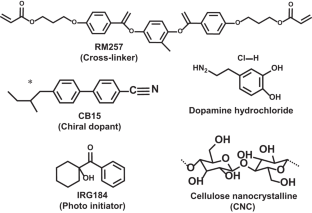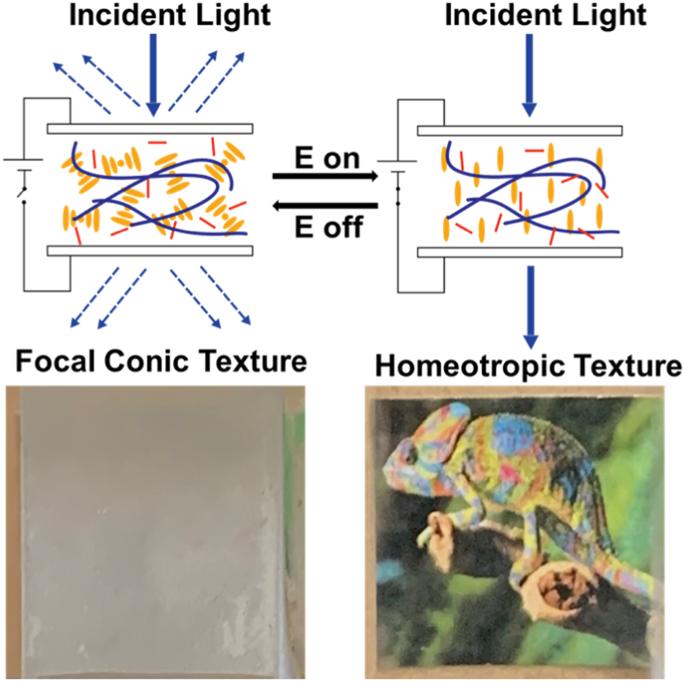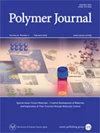Improving the electro-optical properties of cholesteric liquid crystal devices via cellulose nanoparticle dopants
IF 2.3
4区 化学
Q3 POLYMER SCIENCE
引用次数: 0
Abstract
In the presence of a strong electric field, helices in a cholesteric liquid crystal (CLC) phase might be unwound, leaving liquid crystal (LC) molecules parallel to the electric field, thereby realizing transparency. Previously, we developed a novel particle-doped CLC cell without alignment layers that exhibited liquid crystal display (LCD) capabilities via electro-optical properties. This ability represents a novel advancement in LCD fabrication, resulting in enhanced electro-optical characteristics. To explore the impact of chirality on LCDs, we synthesized and radially constructed cellulose particles. These were then employed as chiral dopants in the production of LCD cells. The fabricated chiral nanoparticle (CNP)-doped PC05 CLC cell showed a high transparency of 97.4% and a fast response time of 7.6 ms. For the prepared radially constructed PDAT-doped PD2T PSCLC cell, a high transmittance of 93.6% and a fast response time of 13 ms were achieved. Fabrication of LCD cells without an alignment layer on substrates was achieved by indicate adding polymeric chiral nanoparticles into CLC mixtures. Adding 2 wt% chiral CNPs promoted the transmittance of the CLCs from 3.4 to 97%. This novel chiral dopant technique enables the use of a new easy method for the fabrication of LCDs. Fabrication of LCD cell without alignment layer on substrates was achieved via simply adding the chiral polymer nanoparticles into CLC mixtures. The fabricated chiral nanoparticle (CNP) doped CLC cell shows a high contrast 97.4% and a fast response time 7.6 ms.


通过纤维素纳米粒子掺杂剂改善胆甾型液晶器件的电光特性
在强电场的作用下,胆甾液晶(CLC)相中的螺旋可能会松开,使液晶(LC)分子与电场平行,从而实现透明。此前,我们开发了一种新型无配位层的颗粒掺杂 CLC 电池,通过电光特性显示出液晶显示(LCD)功能。这种能力代表了液晶制造领域的新进展,从而增强了电光特性。为了探索手性对液晶显示器的影响,我们合成并径向构建了纤维素颗粒。然后将这些颗粒作为手性掺杂剂用于液晶电池的生产。制作的手性纳米粒子(CNP)掺杂 PC05 CLC 电池显示出 97.4% 的高透明度和 7.6 ms 的快速响应时间。在制备的径向构造 PDAT 掺杂 PD2T PSCLC 电池中,实现了 93.6% 的高透光率和 13 ms 的快速响应时间。通过在 CLC 混合物中添加聚合物手性纳米粒子,可以在基底上制作出无配向层的 LCD 电池。添加 2 wt% 的手性 CNPs 使 CLC 的透光率从 3.4% 提高到 97%。这种新颖的手性掺杂剂技术为制造液晶显示器提供了一种新的简便方法。
本文章由计算机程序翻译,如有差异,请以英文原文为准。
求助全文
约1分钟内获得全文
求助全文
来源期刊

Polymer Journal
化学-高分子科学
CiteScore
5.60
自引率
7.10%
发文量
131
审稿时长
2.5 months
期刊介绍:
Polymer Journal promotes research from all aspects of polymer science from anywhere in the world and aims to provide an integrated platform for scientific communication that assists the advancement of polymer science and related fields. The journal publishes Original Articles, Notes, Short Communications and Reviews.
Subject areas and topics of particular interest within the journal''s scope include, but are not limited to, those listed below:
Polymer synthesis and reactions
Polymer structures
Physical properties of polymers
Polymer surface and interfaces
Functional polymers
Supramolecular polymers
Self-assembled materials
Biopolymers and bio-related polymer materials
Polymer engineering.
 求助内容:
求助内容: 应助结果提醒方式:
应助结果提醒方式:


